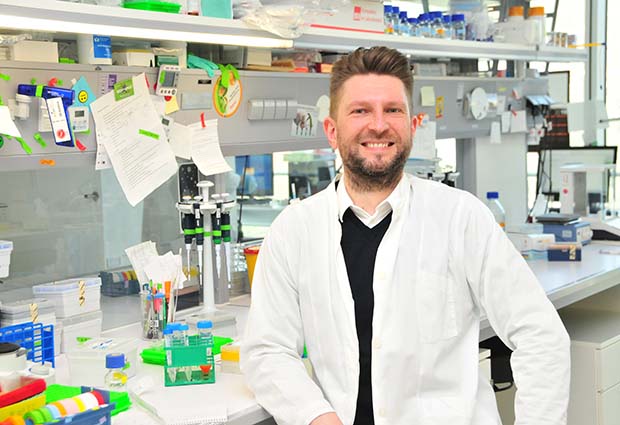
Read the latest Issue
Ageing, longevity, the naked mole-rat and us

It was more by serendipity than design that Alessandro Ori came to be studying the molecular mechanisms associated with ageing and longevity. During his postdoc at EMBL, he ventured down a research rabbit hole that was to shape the course of his career in ways he hadn’t anticipated, leading not to rabbits but to the naked mole-rat, Heterocephalus glaber.
Prior to becoming a group leader at the Leibniz Institute on Aging – Fritz Lipmann Institute (FLI), in Jena, Germany, Ori worked on mass spectrometry-based proteomics in the Beck group in Heidelberg for five years. One of the group’s main areas of research was the nuclear pore complex – a large complex of proteins that allows the transport of molecules into and out of the cell’s nucleus. This led to a collaboration with Martin Hetzer of the Salk Institute in California, USA. Hetzer was interested in studying how the nuclear pore was affected by ageing.
“It was one of many side projects I was working on at the time,” Ori explains. “As part of my postdoc I developed mass spectrometry techniques to quantify precisely the proteins that form the nuclear pore. Working with Martin Hetzer, we decided to look at the brains of young and old rats. Then the project expanded in scope from the nuclear pore to a proteome-wide analysis, and we also started to integrate genomics approaches. I found myself somehow sidetracked into the ageing field, and it suddenly became very important!”
I found myself sidetracked into the ageing field
When the time came for Ori to leave EMBL, Lenhard Rudolph at FLI was looking for someone to set up a proteomics facility there, and to work on proteomics in the context of ageing. Ori realised that this was no longer a side project but a great opportunity to immerse himself more fully in this area of research.

At first glance, a small, wrinkly, hairless rodent with tiny eyes and ears might seem to have little in common with humans. Or with bees, for that matter. However, like us, naked mole-rats are exceptionally long lived relative to their body mass (up to 30 years, compared to 2–3 years for mice and about 12 for guinea pigs). And, like bees, they have a eusocial lifestyle: they live in colonies comprising a queen, several breeding males, and up to 300 male and female workers. They are native to the savannahs of East Africa, where they live underground in extensive tunnel systems.
Naked mole-rats have a number of special characteristics that differentiate them from other rodents, and indeed from humans, and make them fascinating subjects for study: they are fertile throughout their lives and are highly resistant to infection, as well as to diseases such as cancer and diabetes. These traits, combined with their extraordinary longevity, make them one of the most interesting model organisms for ageing research.
They live long, but do they age? This question was a source of much debate and speculation in the scientific community, and one that Ori and his collaborators sought to answer definitively. Using a combination of proteomic and genomic approaches, they compared liver samples from naked mole-rats with those from guinea pigs and humans. They also compared the livers of young and old naked mole-rats.
“We found that naked mole-rats and closely related species showed differences in their mitochondria – the cellular components that generate energy,” says Ori. “Our data also clearly showed age-dependent changes in protein levels in the livers of young and old individuals. The molecular signature is actually similar to other organisms; it’s just that it’s happening at a different pace. It’s slower.”
Perhaps one of the most significant findings of Ori’s research is that ageing affects similar molecular pathways in the livers of naked mole-rats and humans. Specifically, ageing affects a group of proteins responsible for eliminating toxic substances from the body. However, whether or not these pathways affect the health of old naked mole-rats remains to be investigated.

Ultimately, the goal of ageing research is not necessarily to extend lifespan in humans, but to extend healthspan: the part of life that we live healthily. “The overall aim is to find fundamental molecular mechanisms that have a causative role in the ageing process,” explains Ori. He emphasises the importance of causation: “We need to identify the molecular changes that are causing ageing, not those that are a consequence of ageing. This has always been one of the trickiest things in the ageing field. If you compare only young and old – extreme age groups – you cannot distinguish that.”
Ori is clear about what is needed if this research is to translate into clinical applications. “If we can find some early event that has a cascade effect, we can try to intervene pharmacologically. You don’t want to have interventions that are effective only if administered from the beginning of life. That’s not what a successful intervention would look like. The aim is to identify populations or age groups that are at risk, and to extend their healthspan by treating them in old age.”
Professor Dame Linda Partridge, Director of the Institute of Healthy Ageing at University College London, echoed some of Ori’s sentiments at a recent Science and Society talk in Heidelberg, ‘What if getting old didn’t mean getting ill?’ Partridge, whose model organism of choice is the fruit fly Drosophila, is part of the quest to find clinical solutions to tackle the growing burden of ill health among older people. Like Ori, her goal is not to make people live longer; that’s happening anyway, with the increasing trend in average lifespan projected to continue until 2030. “People are living longer, but the added years tend to be years of disability and ill health. What we’re trying to do is find ways of compressing that period of ill health at the end of life,” she says.
Her own research focuses on the genetics of ageing, which she believes may be the key to tackling ageing-related disease. After all, some organisms – for example, the sea anemone and the freshwater hydra – seem not to age at all, showing no signs of deterioration over time. “We know that the difference between these species that either age very slowly or don’t age at all, and species that age more quickly, is genetic,” says Partridge. “So we’re trying to find genes that influence the rate of ageing. They’re clearly there, if we can just discover what they are.”
Ageing is a surprisingly malleable process
Partridge believes that the results from animal studies, combined with the FDA’s recent recognition of ageing as a disease – which will facilitate clinical drug trials – offer hope that effective preventative therapies may be on the horizon. “Ageing is a surprisingly malleable process and we can modulate it genetically,” she explains. “In animals, we can slow ageing through diet, genetic mutations, and drugs, and thus protect them against diverse diseases. We’re hoping that this is pointing towards a preventative medicine for people.”
As Ori returns to his lab, and his naked mole-rats, he is optimistic that he is on the right path: “If we can understand the fundamental mechanisms of ageing at the proteome level – both the causes and the consequences – I think we can find the magic bullet.”
Looking for past print editions of EMBLetc.? Browse our archive, going back 20 years.
EMBLetc. archive